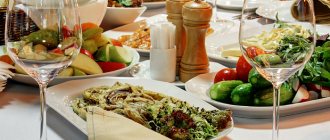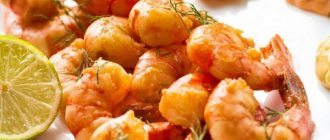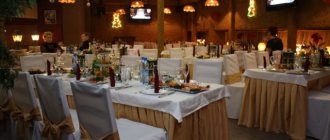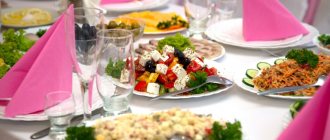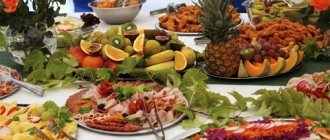How to calculate dishes for a banquet menu and achieve the ideal balance between appetizers, main courses, desserts and drinks? If you order outdoor catering, the manager will go into all the details and create a menu based on the number of guests. Have you decided to organize a banquet yourself, but don’t know how much food and drinks to prepare?
There are standards for the yield of dishes per person depending on the duration of the event:
- 1–2 hours – total yield 200–400 g;
- 2–4 hours – 400–600 g;
- 4–6 hours – 600–1200 g;
- more than 6 hours - over 1200 g.
What should you consider when creating a banquet menu?
- When calculating the amount of food at a banquet, it is important to ensure that the tables are not empty. It is convenient to serve salads in portions, and hot dishes and vegetables on shared trays.
- Plan a special menu for children's meals and vegetarians. Children eat little, but drink more juices and sparkling water. Vegetarians prefer vegetables and fruits to meat and fish.
- Buy cake and alcohol yourself. This will save your budget. Arrange to pick up remaining food and alcoholic beverages after the party.
- When creating a menu, take into account the season. In summer, guests drink more wine, lemonade and juice. In winter, soups, hot snacks and strong alcohol are popular.
How to calculate the amount of food
To make an accurate and correct calculation of food for a wedding, you need to know the generally accepted norms for food consumption, the number of adult guests, and the number of children present at the celebration.
Everyone knows that guests actively eat and drink only at the beginning of the celebration.
At this time, toasts and congratulations are heard. Adults drink and snack, and children taste the beautiful sweet dishes with interest.
You can calculate the amount of food by knowing the weight of one serving for an adult or a child. It is important to take into account the calorie content of each dish and the fact that, having quickly become full at the very beginning of the banquet, guests will not actively consume hot food.
If the hosts of the holiday want to provide tasty and satisfying food to the guests, giving them the opportunity to try each of the prepared dishes, they should think about what should be the weight and volume of the portions placed on the tables at the very beginning of the banquet.
Knowing the exact number of guests invited to the wedding and the standard of products for preparing one serving of a particular dish, you can safely begin to calculate the total amount of products that will be used to prepare salads, main dishes, and snacks.
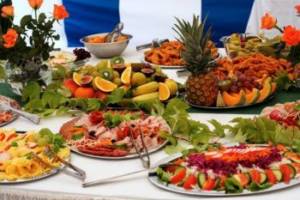
These standards are different for sausages, meat, fish, poultry, cheeses, vegetables and fruits. Before you start making calculations, you need to find out the number of guests and the exact amount of food needed to prepare one serving of food and have a menu already drawn up.
The number of drinks depends on the time of year in which the date of the gala banquet falls. During the hot season, you will have to provide a large amount of water.
Remembering that the main dish of any wedding is always the cake, it is important to make sure that you have the right amount of tea and coffee.
How to calculate cold appetizers
When calculating snacks for a banquet, use the following data.
- The standard yield of cold appetizers per person is 350–400 g. These include cheese, vegetable and meat slices, mini-sandwiches, canapés, and rolls.
- Salads are served at the rate of 200–250 g per person. The most popular are Caesar, herring under a fur coat, vinaigrette, and various seafood dishes.
All snacks are divided into several parts and served as needed. Most food is consumed in the first part of the banquet, when hot dishes are not yet prepared.
How to correctly calculate a banquet menu for 10-20 people?
Based on the practice of events already held, the wedding banquet provides for some structure for the removal of food. The first step is to take into account what is customary to offer guests so that they are full and satisfied.
A buffet table must be set for those invited while they wait for the newlyweds to arrive from the registry office.
This includes low alcohol drinks and canapés . Salads, two hot dishes of poultry and fish and a wedding cake are served at the table. It should contain appetizers of meat, vegetables, cheese, mushrooms - so almost every guest at your celebration will find an appetizer for themselves: a vegetarian, a meat lover, a person on a diet .
Proper adherence to the quantity and quality of treats can be exemplified by a banquet menu in a cafe for 25 people. It is difficult to accommodate such a number of guests at home, so a café would be the right option for holding the celebration. To make it convenient to take food, it is worth placing each treat on three plates and thus it turns out that for every 7-8 people there will be salad and cold cuts . The gender of the invitees should also be taken into account. If there are more men, then you need to add meat, cheese and fish cuts.
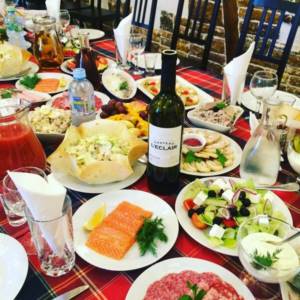
Example of a banquet menu for 25 people
There must be three salads and a lot of cold appetizers, since guests actively eat for the first 20-25 minutes, and then only drink and snack . It is also worth calculating the amount of caviar for such a banquet. According to the experience of practitioners - people who prepare food for weddings, there will be enough caviar for such a number of guests in the following volume:
- three cans of caviar, 140 grams each;
- butter - 420 grams.
Calculation of hot dishes
When calculating the number of hot dishes at a banquet, they are guided by the following figures:
- meat and fish dishes (steaks, chops, roasts) - 250 g per person;
- side dishes (potatoes, rice, stewed vegetables) - 150 g;
- soup (solyanka, broth with croutons, fish soup) - 250 g.
As a rule, at large-scale feasts two hot meat dishes are served. One is brought to guests in the first part of the event, the second is brought closer to the end of the holiday. Sometimes one dish is divided into two servings.
How to choose drinks
When choosing alcohol for a large-scale event, you need to remember one important point: if you don’t know the company’s preferences well, it is best to take classic alcohol - champagne, wine, vodka.
Various original drinks - tequila, martini - can only be purchased if you clearly understand that your guests drink exactly them. Calculating alcohol is a little more complicated than food; there is also a gender principle here. If the majority of your company is men, we calculate this: 0.75 liters of wine, 0.7 liters of vodka, 0.3 liters of champagne for each guest. If the company is mainly female, the calculation is different: 1.2 liters of wine, 0.5 liters of vodka, 0.5 liters of champagne.
Both water and water must be present on any table. Moreover, it is advisable to choose several types of juices, including fruit drinks, at the rate of 1.5 liters per person (in summer it is better to take 2 liters). Water is usually offered in two types: with gas and without gas at the rate of 0.5 liters per person (and there should be more water without gas than with gas).
Don't forget about tea and coffee for dessert!
Let us separately dwell on the intricacies of preparing for a picnic. In general, the approach to grocery shopping will be the same. It is only worth noting that the traditional dish for a picnic is, of course, shish kebab, for the preparation of which you need to buy two types of meat: pork (or lamb) and chicken (or turkey). As a rule, meat for barbecue is prepared at the rate of 300-400 grams per person. Of course, you can take more fresh vegetables and herbs (about 300 grams each).
Don't forget to buy bread (at the rate of 5-7 pieces per person) or lavash. Various pickles (about 150 grams per person) are also great for a picnic.
- When creating a menu, it is necessary to focus on the time of year, since in the summer, for example, most people tend to eat lighter foods (vegetables, seafood, fruits).
- If you are cooking for a large company, try to make the dishes as simple as possible, homemade and tasty.
- Don’t forget about beautiful atmospheric table settings and table decorations, for example, a bouquet of flowers.
- We put on the table: butter, various types of sauces and seasonings (mustard, ketchup, horseradish).
- If there are children at the event, there should be more non-alcoholic refreshing drinks. You can provide a separate special treat for children that will delight them, for example, a milkshake or cut fruit in cups.
MENU CALCULATION FOR A WEDDING BANQUET
The most economical option is if you (provided that you are organizing the wedding yourself) or we (while we take care of everything) manage to negotiate with a restaurant/cafe about permission to use their own alcohol for the banquet. In a very good situation, you can bring not only your own alcohol, but also your own cold snacks, which do not need cooking, and fruit. But how to calculate the norm/amount of alcohol or snacks? On average: The number of servings per person is easy to calculate. On average, 50-60 grams of salad or other snack is enough for one person. Moreover, as we know, guests actively eat only in the first 15-20 minutes. feast, and after that they drink more. At the end of the appetizers, warm dishes follow. There should be at least several of them. Traditionally this is meat (poultry) and fish. The warm dishes are followed by dessert and, finally, the highlight of the program - the wedding cake. Before ordering a cake, you need to consider the number of guests. So that everyone has the opportunity to enjoy a masterpiece of culinary art, estimate the approximate weight of the cake based on 2 kg for 10 guests. If there are 50 people at the banquet, a cake weighing 10 kilograms will be just right. If you understand the habits of your guests well, it will be easier for you to calculate the quantity and decide on the range of drinks. But on average, the following figures can be taken as a guide: 3-4 bottles of spirits, 3-4 bottles of wine, 2-3 bottles of champagne per 10 people.
Please note: in summer a large amount of water is needed
The menu and number of servings will help you choose in your restaurant or cafe. You shouldn’t get carried away and order a bunch of food: - 3-5 types of salads and appetizers (1 serving per person, or in addition half a serving). — Assorted meat, fish, vegetables — Warm appetizer. — One or two types of warm food with a side dish. — Ice cream — Fruit — tea and coffee. It is possible to try to agree to bring some of your own products - the same cuts, caviar, fruits. It will be much cheaper.
Below you will find the necessary list of calculations for drinks and food for 1 person, from which you can base when drawing up your banquet menu.
Cold appetizers and aperitif:
1. Cold cuts: we recommend 3 types of meat (carbonate, neck, etc.) 40 g net/person of each type and 1 type of raw smoked sausage 20 g/person 2. Hard cheese (1-2 types) 20-25 g/person 3. Vegetables: 50 g/person (cucumbers, tomatoes, radishes); sweet pepper (preferably red and yellow) - 25-30 g per person; greens - cilantro, parsley, dill (mostly for decorating dishes) 4. Pickles: cucumbers and tomatoes (preferably not pickled) 40-50 g each; mushrooms - 30-40 g; olives/olives - 10 g each; wild garlic and pickled garlic at banquets, in most cases, are not popular 5. Fish: each red and white (preferably warm smoked sturgeon) - net 40 g (note that out of 6 kg of unprocessed red fish, 4 kg will remain at the end of processing) 6. Caviar: red (chum salmon) - 15-20 g per person, dark - 10 g 7. Fruits (quantity primarily determines the time of year): lemons, tangerines, grapes (green and dark), apples (small) , pears, etc.; Bananas are strongly not recommended in winter (they turn black very quickly) 8. For an aperitif: fruits, chocolates in boxes and nuts (hazelnuts, almonds, peanuts, etc.) 9. Wedding cake: 100-150 g per person
1. Juices and water: more than 1 liter per person. Juices - no more than 2 types (apple/grape/fruit juice and orange); min. water and cola - we strongly recommend small bottles (0.5 - 0.6 l), despite the fact that 2 liters are more profitable, but the tables will not be forced by bulky containers 2. Champagne: according to tradition, 2 bottles are inviolable, which will be placed in front of the newlyweds (one is drunk on their wedding anniversary, the other on the birth of their first child); and a maximum of 1-2 toasts for all guests (150-200 g per person) 3. Wine: we recommend only red (since the reprimand, in most cases, in the banquet menu is made on meat) - 1/2 bottle 0 ,75l per person 4. Vodka, whiskey, cognac and vermouth: it’s difficult to advise or recommend anything. Only you, knowing your guests, have the opportunity to assess their capabilities. But we recommend purchasing whole alcohol with a small reserve, so as not to run out twice, and so that the guests do not mix it up if their favorite drink runs out.
When creating an ideal wedding menu for 1 person, the following calculation is applied:
salads - about 200 gr., cold appetizers - 150 gr., hot dishes - 250 gr., hot appetizers - 150 gr., side dish - 100 gr., dessert - 150-200 gr., bread - 150 gr.
Calculation of alcohol and drinks:
Vodka - 1 bottle for 2 people, wine - 1 bottle per person, champagne - 1 bottle for three, soda, juice, mineral water - 1.5-2 liters per person.
It is best to come to a restaurant to order a wedding banquet during the day (optimally before 15-00). At this time it is quiet and calm. The evening program has not yet started, loud music does not interfere with the conversation, and the visitors who are there are most often still sober and having dinner calmly.
The pleasure you and your invited guests receive from the holiday directly depends on the quality of service, food, drinks and the efficiency of the waiters. And in order to take into account all the client’s wishes, an experienced administrator tries to get as much information from you as possible about the upcoming celebration. How best to arrange the tables, seat the guests, after what time to serve hot dishes, when the banquet ends - you will answer these and other questions, because a good banquet and organization of your holiday is the direct responsibility of the administrator.
After all organizational issues have been discussed, it will be the turn to open the menu and choose dishes for the invited guests. What is the best food to choose? The answer to this question is ambiguous. Each person has his own taste and habits. And you really want absolutely everyone to like it!
The most economical option is if you (provided that you are organizing the wedding yourself) manage to negotiate with a restaurant/cafe to allow you to use “your” alcohol for the banquet. In a very good situation, you can bring not only “your” alcohol, but also “your” cold snacks that do not need cooking, and fruit.
The serving size per person is easy to calculate. On average, 50-60 grams of salad or other snack is enough for one person. Appetizers are followed by hot dishes. There must be at least two. Traditionally this is meat (poultry) and fish. The hot dishes are followed by dessert and, finally, the highlight of the program - the wedding cake. Before ordering a cake, you need to consider the number of guests. So that everyone can enjoy a masterpiece of culinary art, estimate the approximate weight of the cake based on 2 kg for 10 guests. If there are 50 people at the banquet, a cake weighing 10 kilograms will be just right. If you know the habits of your guests well, it will be easier for you to calculate the quantity and decide on the range of drinks. But on average, the following figures can be taken as a guide: 3-4 bottles of spirits, 3-4 bottles of wine, 2-3 bottles of champagne for 10 people.”
Please note: in summer you need a lot of water!!!
The menu and number of servings will help you choose in your restaurant or cafe. Don’t get carried away and order a bunch of food: - 3-5 types of salads and appetizers (1 serving per person, or even half a serving). — Assorted meat, fish, vegetables — Hot appetizer. — One or two types of hot dishes with side dishes. — Ice cream — Fruit — tea and coffee.
What kind of alcohol will be drunk at your wedding depends on your personal preferences and the amount of money. But usually it's vodka, wine and champagne. Cognac, martini, white wine, whiskey, liqueur, etc. - all this is “not for everybody” and is drunk much less often.
Separately:
1. If you have planned a walk* with your guests before the banquet, do not forget about champagne, water, sweets, sandwiches, napkins and disposable tableware. By the way, we recommend buying glasses made of transparent plastic so that it looks aesthetically pleasing in photographs. Plastic cups look terrible! 2. It is likely that your banquet hall/restaurant/cafe will ask you to pay for cutting and serving the food you brought. 3. As practice shows, few of your guests will remember in a couple of weeks what exactly they ate at your wedding, but photographs and videos will remind you of how beautifully this evening was organized for many, many years to come.
*When calculating alcohol, it is important not to forget that you will also drink at home, in the registry office, and while out for a walk. For these purposes, it is better to use champagne or wine. 1. At home (with the bride and groom) - only 3-4 bottles 2. On a walk - 0.5 bottles for each person walking 3. At the registry office - only 2-3 bottles It’s also better to take soda or mineral water - six bottles, per just in case. 2 more bottles of champagne must be prepared for tying with a ribbon (at the banquet). You will drink one on your first wedding anniversary, and the second at the birth of your first child. If this amount seems not enough for you, feel free to take more. After all, everything that remains will be drunk on the second day or subsequent holidays.
A wedding celebration is an event that requires a lot of effort and money. In order for the holiday feast to go well, you need to devote time to thinking through what dishes and drinks will be on the table. Long before the celebration, the newlyweds and their loved ones think about how to plan the wedding menu so that the guests enjoy the treats.
- In order to decide on the choice of dishes and drinks for the festive table, you need to decide how many people will be at the event. You should write down the names of those who definitely need to be invited to the wedding.
- The next important point is the duration of the feast. The celebration may be celebrated for only two hours or last until late at night.
- Next to each name of the invitee, you need to make notes about what food preferences he has or what diet he follows. Based on this data, the menu needs to be adjusted. If the wedding is expected to be large, it will not be easy to find out such details about all the guests. Therefore, you will have to choose dishes that most people like.
- You should not cook or order unknown dishes. New recipes must be tried first.
Dessert calculation
When calculating the food yield per person that will be optimal for a wedding banquet, be sure to take into account desserts and fruits. The standard portion of fruit per guest is 200 g. It includes:
- bananas - 0.5 pcs.;
- apples and pears - 1 pc.;
- tangerines - 2 pcs.;
- oranges - 1 pc.;
- kiwi - 0.5 pcs.;
- strawberries - 50 g;
- pineapple - 1 ring;
- grapes - 50 g.
The cake is ordered taking into account that there should be a portion weighing 150–200 g per person. The fruits are cut and placed in vases. Moreover, they do this several times so that the slices do not become weathered and lose their appearance.
Wedding menu for 50-60 people in a restaurant
Such a celebration becomes quite a voluminous event in terms of organizing the table and material costs for filling it. Calculation of the menu for a wedding table for 50-60 people starts from the calculation of products per person with a small margin, based on the duration of the banquet . To organize a holiday in a restaurant, you should consider the number of different dishes:
- from three to five different salads – 300 grams;
- cold snacks – 300 grams;
- hot dishes, side dishes – 600 grams;
- sweets, cake, fruits – 500 grams;
- soft drinks – 1.5 liters;
- alcohol – 1 liter.
This list of products and their quantity is designed for an adult; for children, the calculation is much less for both food and drinks, and alcohol is not taken into account at all
In order to set the table, you need to prepare a variety of dishes:
- sliced smoked poultry or specially smoked sausage;
- various rolls as cold appetizers;
- fish slices;
- canapés, sandwiches, snack baskets.
Moreover, hot dishes in the form of roasted pig, stuffed pike, duck with apples, rice and potatoes can be served on large common dishes. It may happen that someone is already full, someone has eaten at home - they have a diet, so portioned hot dishes are not always appropriate and can remain on the plates either untouched or simply mixed.
The amount of food should be optimal, since there are often cases when the volume of treats on the table is excessive, and this is a material cost; it is also worth avoiding the situation when there are not enough products and you have to hastily buy more.
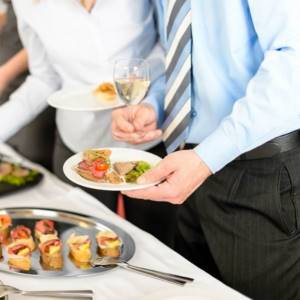
Amount of food per person at a wedding banquet
Calculation of drink norms per person
Before calculating soft drinks and alcohol, take into account what food will be at the banquet. Guest preferences are also important. Drinks for everyone include all kinds of liqueurs, martinis, whiskey, and cognac. Vodka, wine and champagne are considered universal alcohol. There are standard formulas:
- vodka - a bottle for 2 people;
- wine - bottle per person;
- champagne - a bottle for 3 people.
The best non-alcoholic drinks are mineral water, juices and fruit drinks. At the same time, they are purchased at a rate of 1.5–2 liters per guest.
Calculating the menu for the wedding
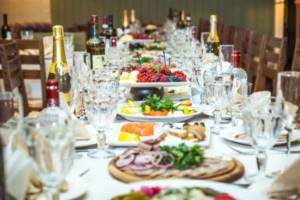
Remember that you cannot do without certain hassles, since you need to create a menu not only taking into account the variety and sophistication of the dishes, but also taking into account their quantity and portion size. No one wants their wedding guests to go home hungry or upset that they didn’t have time to try the delicacy. It is important to clearly understand whether there will be 20, 50 or more guests at the banquet.
Remember versatility
The menu for the wedding table should be universal, that is, the dishes should be interchangeable so that each of the guests can try whatever they want. The menu at a wedding banquet should be varied; you need to think about not only the availability and composition of hot dishes, but also take care of vegetables, fruits, and cold appetizers.
The main task:
- Calculate the total number of dishes and their ratio to the invited people.
- Calculate portions.
- Select ingredients for dishes.
What to consider when creating a menu
After reviewing the range of dishes offered by the establishment, decide for yourself which ones you would like to order. You should not take into account dishes that you have never tried.
If you are on a limited budget, you should not choose expensive options, since there are similar ones, but at a more reasonable price.
It is very important to diversify the menu. You need to order snacks of different composition, since guests have different tastes, and someone may prefer meat, another fish, and another vegetable.
During the banquet there must be at least 2 hot dishes: one general and the other individual. If the celebration lasts more than 7 hours, then you can add one more hot dish (3 in total).
Check with the administrator about alcoholic drinks: how much you can bring your own. In establishments, alcohol is more expensive than in a store, so there is often an unspoken amount for which you need to order in a restaurant, and you can take the rest of your own.
A buffet table will be very useful for young guests awaiting their arrival, and some will also want to have a snack during the gift ceremony (while they are waiting for their turn). Light snacks (sandwiches, canapés), fruits, and don’t forget champagne and wine are suitable for the buffet. When ordering wedding decor, remember that the buffet table also requires the attention of decorators.
Calculation and preparation of a wedding banquet menu
When calculating food for a wedding banquet, keep in mind that the main feast is usually preceded by a small buffet. For the welcome zone you will need champagne, several snacks and fruits.
For a banquet that lasts 4–5 hours, you need 1400–1500 g of food per guest (including cake). The following ratio of main courses and snacks on the banquet table is considered optimal.
- Cold appetizers (cheeses, vegetables, cold cuts) - 350–400 g.
- Salads (vegetables, meat, seafood) - 200 g.
- Hot snacks - 100 g.
- Hot (steaks, chops, roast) - 250 g.
- Side dishes - 150 g.
- Fruits - 200 g.
- Cake - 150–200 g.
If 10–15 guests are invited to the wedding, it is better to order a cake based on a portion of 200 g. If the celebration is large-scale, 150 g per guest is quite enough.
Soft drinks:
— carbonated sweet water – 0.5 l; – mineral water – 0.5 l; – fruit juice – 0.5 l; — sparkling water like “Schweppes” — 0.3 l; — coffee – 2 cups (200 ml); – tea – 2 cups (300 ml); – milkshake – 200 ml; – hot chocolate – 200 ml.
If there are children at the banquet, the number of non-alcoholic refreshing drinks should be greater.
As for alcoholic beverages, consider that men usually drink strong alcoholic drinks (vodka, cognac, martini, whiskey), while women prefer light cocktails, red and white wine. The average calculation of alcoholic drinks is approximately 0.5 liters of each per person. Champagne should be served at the beginning of the feast at the rate of 100 ml per person. Good luck!
Depends on the season
If the weather on the wedding day is hot, then it is advisable to diversify the menu of the wedding banquet for 20 people with light snacks and cold desserts. For example, the following dishes may be placed on the table for a summer or autumn wedding:
- canapés with oranges, fried chicken and pineapples;
- tartlets with tomatoes, melted cheese, mayonnaise and garlic;
- sandwiches or toast with red caviar;
- vegetable mix;
- cold cuts;
- “Red Sea” salad made of tomatoes, crab sticks, cheese, garlic and mayonnaise;
- “Lady” salad made from Chinese cabbage, ham, corn, croutons and mayonnaise;
- “Mood” salad made of white and red beans, corn, cabbage, tomatoes, herbs and mayonnaise;
- chicken aspic;
- pork fricassee with mushrooms, sour cream and melted cheese, and rice as a side dish;
- portioned ice cream, jelly, soufflé or mousse.
In summer and autumn, nature delights with fresh fruits, so if the banquet is held at home, then be sure to include a large amount of vegetables in the wedding menu for 20 people. In winter, on the contrary, the menu should contain a lot of meat or fish:
- canapés with salmon, curd cheese and quail eggs;
- tartlets with liver pate;
- sandwiches or toast with red caviar;
- cold cuts;
- vegetable mix;
- sausage and cheese slices;
- salad with chicken breast, hard cheese, eggs, mushrooms, onions and mayonnaise;
- “Inspiration” salad with beef, tomatoes, hard cheese, herbs, garlic and mayonnaise;
- “Funchoza” salad with cucumber, pepper, carrots and mushrooms;
- fish in batter;
- beef langet with potatoes;
- chocolate cupcake with hot liquid chocolate inside.


